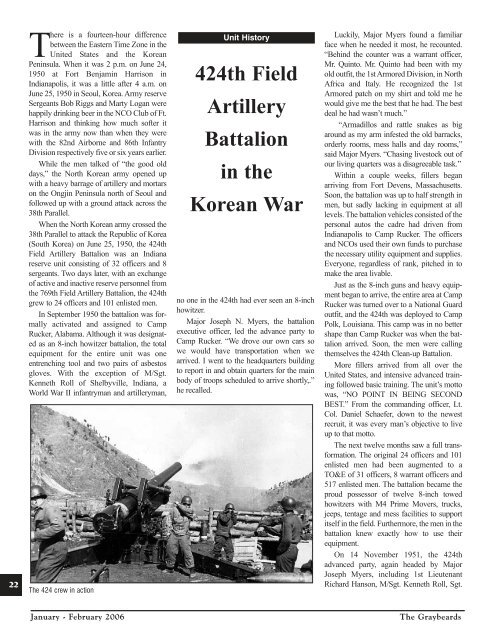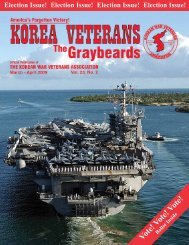Jan/Feb 2006 - Korean War Veterans Association
Jan/Feb 2006 - Korean War Veterans Association
Jan/Feb 2006 - Korean War Veterans Association
You also want an ePaper? Increase the reach of your titles
YUMPU automatically turns print PDFs into web optimized ePapers that Google loves.
22<br />
There is a fourteen-hour difference<br />
between the Eastern Time Zone in the<br />
United States and the <strong>Korean</strong><br />
Peninsula. When it was 2 p.m. on June 24,<br />
1950 at Fort Benjamin Harrison in<br />
Indianapolis, it was a little after 4 a.m. on<br />
June 25, 1950 in Seoul, Korea. Army reserve<br />
Sergeants Bob Riggs and Marty Logan were<br />
happily drinking beer in the NCO Club of Ft.<br />
Harrison and thinking how much softer it<br />
was in the army now than when they were<br />
with the 82nd Airborne and 86th Infantry<br />
Division respectively five or six years earlier.<br />
While the men talked of “the good old<br />
days,” the North <strong>Korean</strong> army opened up<br />
with a heavy barrage of artillery and mortars<br />
on the Ongjin Peninsula north of Seoul and<br />
followed up with a ground attack across the<br />
38th Parallel.<br />
When the North <strong>Korean</strong> army crossed the<br />
38th Parallel to attack the Republic of Korea<br />
(South Korea) on June 25, 1950, the 424th<br />
Field Artillery Battalion was an Indiana<br />
reserve unit consisting of 32 officers and 8<br />
sergeants. Two days later, with an exchange<br />
of active and inactive reserve personnel from<br />
the 769th Field Artillery Battalion, the 424th<br />
grew to 24 officers and 101 enlisted men.<br />
In September 1950 the battalion was formally<br />
activated and assigned to Camp<br />
Rucker, Alabama. Although it was designated<br />
as an 8-inch howitzer battalion, the total<br />
equipment for the entire unit was one<br />
entrenching tool and two pairs of asbestos<br />
gloves. With the exception of M/Sgt.<br />
Kenneth Roll of Shelbyville, Indiana, a<br />
World <strong>War</strong> II infantryman and artilleryman,<br />
The 424 crew in action<br />
Unit History<br />
424th Field<br />
Artillery<br />
Battalion<br />
in the<br />
<strong>Korean</strong> <strong>War</strong><br />
no one in the 424th had ever seen an 8-inch<br />
howitzer.<br />
Major Joseph N. Myers, the battalion<br />
executive officer, led the advance party to<br />
Camp Rucker. “We drove our own cars so<br />
we would have transportation when we<br />
arrived. I went to the headquarters building<br />
to report in and obtain quarters for the main<br />
body of troops scheduled to arrive shortly,.”<br />
he recalled.<br />
Luckily, Major Myers found a familiar<br />
face when he needed it most, he recounted.<br />
“Behind the counter was a warrant officer,<br />
Mr. Quinto. Mr. Quinto had been with my<br />
old outfit, the 1st Armored Division, in North<br />
Africa and Italy. He recognized the 1st<br />
Armored patch on my shirt and told me he<br />
would give me the best that he had. The best<br />
deal he had wasn’t much.”<br />
“Armadillos and rattle snakes as big<br />
around as my arm infested the old barracks,<br />
orderly rooms, mess halls and day rooms,”<br />
said Major Myers. “Chasing livestock out of<br />
our living quarters was a disagreeable task.”<br />
Within a couple weeks, fillers began<br />
arriving from Fort Devens, Massachusetts.<br />
Soon, the battalion was up to half strength in<br />
men, but sadly lacking in equipment at all<br />
levels. The battalion vehicles consisted of the<br />
personal autos the cadre had driven from<br />
Indianapolis to Camp Rucker. The officers<br />
and NCOs used their own funds to purchase<br />
the necessary utility equipment and supplies.<br />
Everyone, regardless of rank, pitched in to<br />
make the area livable.<br />
Just as the 8-inch guns and heavy equipment<br />
began to arrive, the entire area at Camp<br />
Rucker was turned over to a National Guard<br />
outfit, and the 424th was deployed to Camp<br />
Polk, Louisiana. This camp was in no better<br />
shape than Camp Rucker was when the battalion<br />
arrived. Soon, the men were calling<br />
themselves the 424th Clean-up Battalion.<br />
More fillers arrived from all over the<br />
United States, and intensive advanced training<br />
followed basic training. The unit’s motto<br />
was, “NO POINT IN BEING SECOND<br />
BEST.” From the commanding officer, Lt.<br />
Col. Daniel Schaefer, down to the newest<br />
recruit, it was every man’s objective to live<br />
up to that motto.<br />
The next twelve months saw a full transformation.<br />
The original 24 officers and 101<br />
enlisted men had been augmented to a<br />
TO&E of 31 officers, 8 warrant officers and<br />
517 enlisted men. The battalion became the<br />
proud possessor of twelve 8-inch towed<br />
howitzers with M4 Prime Movers, trucks,<br />
jeeps, tentage and mess facilities to support<br />
itself in the field. Furthermore, the men in the<br />
battalion knew exactly how to use their<br />
equipment.<br />
On 14 November 1951, the 424th<br />
advanced party, again headed by Major<br />
Joseph Myers, including 1st Lieutenant<br />
Richard Hanson, M/Sgt. Kenneth Roll, Sgt.<br />
<strong>Jan</strong>uary - <strong>Feb</strong>ruary F<br />
<strong>2006</strong><br />
The Graybeards

















